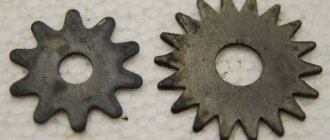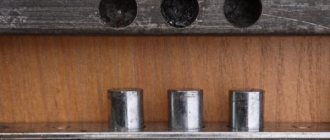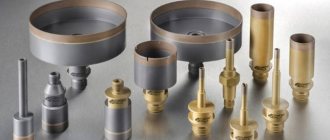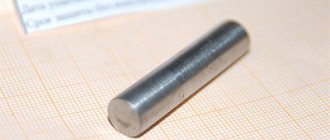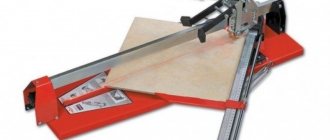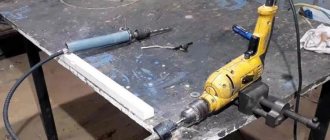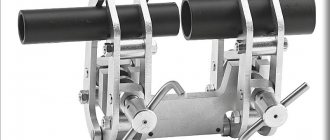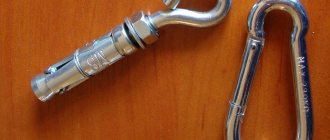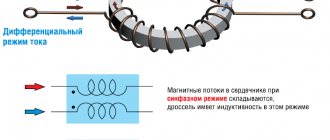Diamond pencil is a dressing tool for abrasive wheels with a high level of wear resistance. It is used for final grinding of the surface of an abrasive wheel to give it its original shape and restore the abrasive properties of the surface. Due to the high hardness of natural or synthetic diamond in comparison with the grinding wheel material, a diamond pencil effectively removes irregularities and allows you to completely restore the properties of the working surface of the workpiece.
Price list for diamond pencils GOST 607-80:
Those who have to deal with metalworking in production using grinding machines know very well that the grinding wheel must be adjusted from time to time in order to restore its geometric shape. In most cases, the grinding wheel is ground unevenly on different sides. Quite often you can find a grinding wheel whose edges are ground off or have a track in the center. In order to properly process a part, in most cases a perfectly flat surface is required. Changing the grinding wheel to a new one every time is not economically profitable, so it is much easier to buy a diamond pencil, with which you can restore the original shape of the wheel.
Tool marking
A unified notation system has been developed for diamond pencils. Thanks to it, you can quickly select the necessary tool. The following items are required:
- trademark of the plant where it was produced;
- final four digits of the article number;
- subgroup of crystals used:
- A - natural origin;
- C - synthetic polycrystals;
- manufacturer's number accepted by the technical specifications.
Diamond pencils come in several types:
- Diamond pencil with a chain arrangement of natural diamonds;
- Diamond pencil with a layered arrangement of natural diamonds;
- Diamond pencil with layered arrangement of synthetic diamonds;
- Diamond pencil with non-oriented arrangement of diamonds.
| Chain arrangement of natural diamonds | |||
| GOST 607-80 | GOST 607-63 | Diamond weight, carat | Weight group, carat |
| 3908-0051 | C 1 | 0,5 | 0,03-0,05 |
| 3908-0052 | c3 | 0,5 | 0,05-0,10 |
| 3908-0053 | C 4 | 0,5 | 0,11-0,20 |
| 3908-0054 | ts5 | 1 | 0,21-0,50 |
| 3908-0055 | — | 0,30-0,50 | 0,31-0,50 |
Note: for dressing wheels of moderate hardness, synthetic diamond analogues are supplied.
| Layered arrangement of natural diamonds | |||
| GOST 607-80 | GOST 607-63 | Diamond weight, carat | Weight group, carat |
| 3908-0081 | C1 | 1.0 | 0,017-0,025 |
| 3908-0082 | C2 | 1.0 | 0,05-0,10 |
| 3908-0083 | C3 | 1.0 | 0,11-0,20 |
| 3908-0084 | C4 | 2.0 | 0,11-0,20 |
| 3908-0085 | C5 | 1.0 | 0,11-0.20 |
Note: for editing of higher hardness, pencils 3908-0085, which have a more durable diamond, are used.
| Layered arrangement of synthetic diamonds | |||
| GOST 607-80 | GOST 607-63 | Diamond weight, carat | Diamond size, microns |
| 3908-0086 | — | 1 | 1250/1000 |
| 3908-0087 | — | 1 | 1600/1250 |
| 3908-0088 | — | 1 | 2000/1600 |
Note: synthetic diamond pencils are used for editing wheels of moderate hardness and diameters up to 600 m.
| Non-oriented diamond arrangement | |||
| GOST 607-80 | GOST 607-63 | Diamond weight, carat | Diamond size, microns |
| 3908-0059 | H1 | 1.0 | 63/50 |
| 3908-0060 | H2 | 1.0 | 100/80 |
| 3908-0061 | H3 | 1.0 | 125/100 |
| 3908-0062 | H4 | 1.0 | 200/160 |
| 3908-0063 | H5 | 1.0 | 315/250 |
| 3908-0064 | H6 | 1.0 | 400/315 |
| 3908-0065 | — | 1.0 | 500/400 |
| 3908-0066 | — | 1.0 | 630/500 |
| 3908-0067 | — | 1.0 | 800/630 |
| 3908-0069 | — | 2.0 | 1000/800 |
Note: These pencils are designed for dressing wheels, providing a high level of grinding finish.
Tool types
The possibility of using a tool mainly depends on its type:
- Type 01 or C – arrangement of crystals in a chain along the axis. Most suitable for internal, external, cylindrical and centerless grinding of shaped surfaces.
- Type 02 or C - arrangement of crystals in layers. Used for fine grinding of abrasive wheels.
- Type 03 – diamond pencils with spherically arranged diamonds.
- Type 04 or H is a tool with a non-oriented arrangement of diamonds, suitable for working with fine-grained grinding wheels by cylindrical or centerless grinding. It is also used for gear grinding of disc and disc wheels, and dressing of single-thread thread grinding wheels.
In addition, the pencil can belong to different brands depending on the weight of the stones, their number, the size of the frame and insert. In accordance with GOST 607-80, diamond pencils are available in three frame designs:
- A - cylindrical;
- B - with a conical body;
- C - stepped.
The weight of stones used depends on the type of pencil:
- When diamonds are arranged in a chain along the axis (type C), high-quality stones weighing from 0.03 to 0.5 carats are used.
- When arranging diamonds in layers (type C), two grades of stones are used for fine- and fine-grained arrangement. With a fine-grained arrangement, each layer contains up to 10 stones. With small grain - from 2 to 5 stones weighing 0.1-0.2 carats.
- For pencils with non-oriented placement of diamonds (type H), crystals of various qualities are used, including chipped and crushed.
What is a diamond pencil
A diamond pencil is a tool steel tool 40-80 mm long, with pressed diamond crystals. Diamonds are pressed onto the underside of the diamond pencil. Depending on what model of diamond pencil is used, its shape and location of the diamonds may vary. All standards for the manufacture of such equipment are regulated by GOST 607-80, but there are pencils for wheels of varying abrasiveness and degree of softness. Diamonds deserve special attention - they can be natural or synthetic.
Device
A diamond edit pencil is a steel pin about 50 mm long, with natural or synthetic technical diamonds located in the lower part. The binder material is a special metal alloy whose coefficient of thermal expansion is close to that of diamonds. Thanks to this, the stones are not subject to additional deformation when heated, which ensures the stability and durability of the instrument.
Diamond pencils, depending on the size and location of the diamonds, are produced for editing by grinding circles with different hardness levels. For this, a tool with a diameter of 80-100 mm is used. which is held manually or fixed in special devices at an angle of 10-15° to the surface being treated.
For processing large diameter wheels and profile grinding, pencils with large diamonds fixed in a frame are used. The advantage of large diamonds is their natural edges and, accordingly, higher resistance to wear compared to diamond-metallic pencils. The setting can be cylindrical, stepped, conical or threaded, and soldering, embossing or a metal clamp is used to secure the diamonds. After fastening, the diamond should protrude from the setting by no more than a quarter of the length, and the plane of the chip does not coincide with the direction of the forces acting on the crystal during editing.
How is a diamond pencil marked?
In order to select the best option for a diamond pencil, the price of which directly depends on the specific application, a unified marking system is used, which can significantly reduce the selection time. These mandatory labeling items include:
- Trademark of the enterprise that produces diamond pencils for straightening wheels;
- Diamond pencil designation excluding the first six characters;
- Subgroups of diamonds used – A-1, A-2, A-3 with corresponding numbers when using natural diamonds and “C” for diamonds based on polycrystals;
- Number according to the manufacturer's internal marking system.
The first five digits of the marking are a standardized designation of the location of diamonds and their weight, which, depending on the model, can be 0.5-2 carats.
Features of editing with a diamond pencil
The technology for straightening with this tool is quite simple and does not require special skills or much effort. Diamond pencils can be used to process both the external and internal surfaces of circles. To ensure maximum contact of the working surface with the workpiece, the tool is placed in a clamp, on a tool rest or other device so that it is inclined at an angle of 10-15 degrees.
The decrease in the quality of abrasive wheels is associated not only with wear of the surface, but also with its contamination with particles of materials that are subjected to grinding. By filling the gaps between abrasive chips, chips and dust make the surface viscous. A diamond pencil removes these contaminants well and restores the processing ability of the grinding chips.
The tool is also used for finishing new circles. Very often their geometry is far from perfect, which is why runout occurs during processing of parts. To check the geometry of the surface, a marker is gradually brought closer to the rotating circle. In curved areas, it begins to leave marks that need to be traced with a diamond pencil. Thus, this tool allows you to improve the quality of processing and avoid mechanical damage to parts and the equipment itself.
Specifics of using a diamond pencil
To restore the cutting characteristics and shape of a grinding tool, using a diamond pencil is a simple process and does not require much effort. The high abrasion resistance of the diamond pencil allows for a constant wheel profile even with regular adjustments. Using a diamond pencil, you can polish the outside or inside of the grinding wheel. The price of a diamond pencil deserves special attention - it depends only on the type of diamond used (natural or synthetic) and its weight, but the cost of such a diamond tool is much lower than regularly replacing grinding wheels.
TECHNICAL REQUIREMENTS
2.1. Pencils must be manufactured in accordance with the requirements of this standard according to working drawings approved in the prescribed manner.
2.2, 2.3. (Excluded, Amendment No. 2).
2.4. In type 03 pencils, the diamonds should be spaced evenly around the sphere.
2.5. The diamonds on the working surface of the pencil must be exposed.
2.6. The surface of the diamond element should not have holes or cracks visible to the naked eye.
2.7. The pencil body must be made of steel grade A20 in accordance with GOST 1414.
(Changed edition, Amendment No. 2).
2.9. Maximum deviations of the Morse cone dimensions - AT8 according to GOST 2848.
(Introduced additionally, Amendment No. 1).
2.10. The specific productivity of pencils made from diamond raw materials of the subgroup "", type 1 and from diamond powders must correspond to that indicated in Table 4a under the editing mode according to clause 4.3.
Characteristics of the grinding wheel
2.12. Pencils of types 01 and 02 (except for pencils 3908-0055, 3908-0073) must have a mark indicating the size of the diamond-bearing part of the pencil.
2.13. Packaging requirements are in accordance with GOST 18088.
2.11-2.13. (Introduced additionally, Amendment No. 2).
ACCEPTANCE RULES
3.1. (Deleted, Amendment No. 2).
3.2. Each pencil is subject to acceptance control for compliance with the requirements of clauses 1.3 (cone size of pencils version B and mounting diameter of pencils versions A and C), 2.4-2.6 and 2.9; 10% of pencils from the batch, but not less than 5 pieces, are subject to compliance with the requirements of paragraphs 1.3 (other sizes) and 2.8; Pencils made of synthetic diamonds with grain sizes 1600/1250 and 1000/800 in the amount of 0.3% of the lot, but not less than 5 pieces, are subject to compliance with the requirements of clause 2.10.
The batch must consist of pencils manufactured in one technological cycle, from one batch of rough diamonds and simultaneously presented for acceptance according to one document.
(Changed edition, Amendment No. 1).
3.3. (Deleted, Amendment No. 1).
3.4. If during acceptance control it is determined that there is non-compliance with the requirements of the standard for more than one controlled indicator, then the batch is not accepted.
If non-compliance with the requirements of the standard is established for one of the controlled indicators, then repeated control is carried out on a double number of pencils for all indicators.
If there are defects in the re-sampling, the batch will not be accepted.
(Changed edition, Amendment No. 1).
3.5. At least 5 pencils made of rough diamonds with a weight of one grain of 0.10-0.20 are subjected to periodic tests for compliance with the requirements of clause 2.10; 0.20-0.50 carats, from diamond grinding powders of 200/160 or 400/315 grit at least once a year.
(Changed edition, Amendment No. 2).
